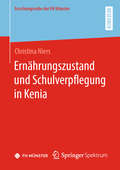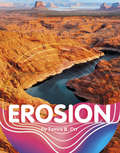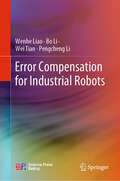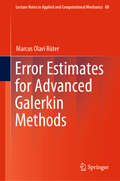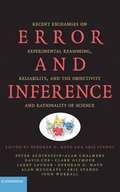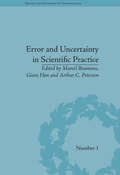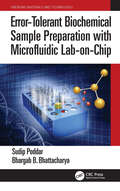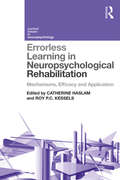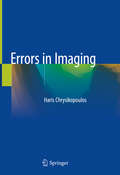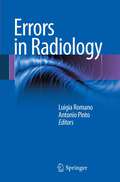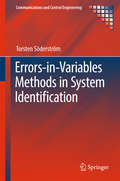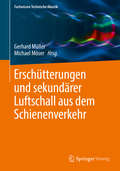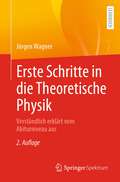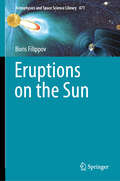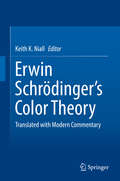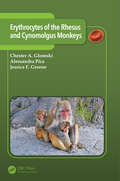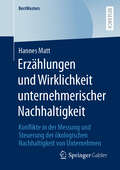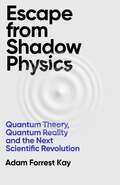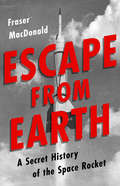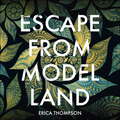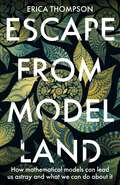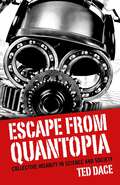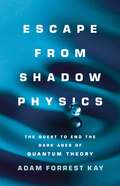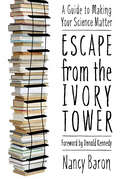- Table View
- List View
Ernährungszustand und Schulverpflegung in Kenia (Forschungsreihe der FH Münster)
by Christina NiersWeltweit hungern 821 Millionen Menschen, vor allem in den Entwicklungsländern. Eine Mangel- und Unterernährung ist für Kinder bis zum fünften Lebensjahr besonders gefährlich und kann ihre Entwicklung irreversibel schädigen.In diesem Buch wird der Ernährungszustand von 174 Vorschul- und Schulkindern aus Diani / Kenia erfasst. Bei 30 Kinder wurde eine Mangel- und/oder Unterernährung beobachtet (Stunting, Wasting und / oder ein reduziertes MUAC). Ein Kind war besonders unterernährt und ein Kind war übergewichtig. Die Ernährungserhebung zeigt, dass vor allem die Versorgung mit Energie, Fett, Proteinen, Vitamin A, Vitamin C, Calcium und Eisen durch die Schulversorgung nicht ausreicht.Auf Grundlage der erhobenen Daten wird eine Strategie für eine nachhaltige Verbesserung der Schulverpflegung entwickelt.Christina Niers hat nach ihrer Ausbildung zur Gesundheits- und Krankenpflegerin (2012) an der Hochschule Osnabrück das Ökotrophologie-Studium absolviert (2015). Seitdem ist sie im Ernährungsmanagement von krankheitsbedingt mangelernährten Patienten tätig. Im Jahr 2019 hat sie das Masterstudium Ernährung und Gesundheit an der Fachhochschule Münster abgeschlossen.
Erosion (Earth Materials and Systems)
by Tamra B. OrrErosion changes Earth's natural features. It breaks down materials and can help make something new. Discover why erosion is an important part of nature!
Error Compensation for Industrial Robots
by Wenhe Liao Bo Li Wei Tian Pengcheng LiThis book highlights the basic theories and key technologies of error compensation for industrial robots. The chapters are arranged in the order of actual applications: establishing the robot kinematic models, conducting error analysis, conducting kinematic and non-kinematic calibrations, and planning optimal sampling points. To help readers effectively apply the technologies, the book elaborates the experiments and applications in robotic drilling and milling, which further verifies the effectiveness of the technologies. This book presents the authors’ research achievements in the past decade in improving robot accuracy. It is straightforwardly applicable for technical personnel in the aviation field, and provides valuable reference for researchers and engineers in various robotic applications.
Error Estimates for Advanced Galerkin Methods (Lecture Notes in Applied and Computational Mechanics #88)
by Marcus Olavi RüterThis monograph provides a compendium of established and novel error estimation procedures applied in the field of Computational Mechanics. It also includes detailed derivations of these procedures to offer insights into the concepts used to control the errors obtained from employing Galerkin methods in finite and linearized hyperelasticity. The Galerkin methods introduced are considered advanced methods because they remedy certain shortcomings of the well-established finite element method, which is the archetypal Galerkin (mesh-based) method. In particular, this monograph focuses on the systematical derivation of the shape functions used to construct both Galerkin mesh-based and meshfree methods. The mesh-based methods considered are the (conventional) displacement-based, (dual-)mixed, smoothed, and extended finite element methods. In addition, it introduces the element-free Galerkin and reproducing kernel particle methods as representatives of a class of Galerkin meshfree methods. Including illustrative numerical examples relevant to engineering with an emphasis on elastic fracture mechanics problems, this monograph is intended for students, researchers, and practitioners aiming to increase the reliability of their numerical simulations and wanting to better grasp the concepts of Galerkin methods and associated error estimation procedures.
Error and Inference: Recent Exchanges on Experimental Reasoning, Reliability, and the Objectivity and Rationality of Science
by Deborah G. Mayo Aris SpanosAlthough both philosophers and scientists are interested in how to obtain reliable knowledge in the face of error, there is a gap between their perspectives that has been an obstacle to progress. By means of a series of exchanges between the editors and leaders from philosophy of science, statistics, and economics, this volume offers a cumulative introduction connecting problems of traditional philosophy of science to problems of inference in statistical and empirical modeling practice. Philosophers of science and scientific practitioners are challenged to reevaluate the assumptions of their own theories - philosophical or methodological. Practitioners may better appreciate the foundational issues around which their questions revolve and thereby become better "applied philosophers." Conversely, new avenues emerge for finally solving recalcitrant philosophical problems of induction, explanation, and theory testing.
Error and Uncertainty in Scientific Practice (History and Philosophy of Technoscience #1)
by Marcel Boumans Giora Hon Arthur C. PetersenAssessment of error and uncertainty is a vital component of both natural and social science. This edited volume presents case studies of research practices across a wide spectrum of scientific fields. It compares methodologies and presents the ingredients needed for an overarching framework applicable to all.
Error-Tolerant Biochemical Sample Preparation with Microfluidic Lab-on-Chip (Emerging Materials and Technologies)
by Bhargab B. Bhattacharya Sudip PoddarMicrofluidic biochips have gained prominence due to their versatile applications to biochemistry and health-care domains such as point-of-care clinical diagnosis of tropical and cardiovascular diseases, cancer, diabetes, toxicity analysis, and for the mitigation of the global HIV crisis, among others. Microfluidic Lab-on-Chips (LoCs) offer a convenient platform for emulating various fluidic operations in an automated fashion. However, because of the inherent uncertainty of fluidic operations, the outcome of biochemical experiments performed on-chip can be erroneous even if the chip is tested a priori and deemed to be defect-free. This book focuses on the issues encountered in reliable sample preparation with digital microfluidic biochips (DMFBs), particularly in an error-prone environment. It presents state-of-the-art error management techniques and underlying algorithmic challenges along with their comparative discussions. Describes a comprehensive framework for designing a robust and error-tolerant biomedical system which will help in migrating from cumbersome medical laboratory tasks to small-sized LOC-based systems Presents a comparative study on current error-tolerant strategies for robust sample preparation using DMFBs and reports on efficient algorithms for error-tolerant sample dilution using these devices Illustrates how algorithmic engineering, cyber-physical tools, and software techniques are helpful in implementing fault tolerance Covers the challenges associated with design automation for biochemical sample preparation Teaches how to implement biochemical protocols using software-controlled microfluidic biochips Interdisciplinary in its coverage, this reference is written for practitioners and researchers in biochemical, biomedical, electrical, computer, and mechanical engineering, especially those involved in LOC or bio-MEMS design.
Errorless Learning in Neuropsychological Rehabilitation: Mechanisms, Efficacy and Application (Current Issues in Neuropsychology)
by Catherine Haslam Roy P.C. KesselsErrrorless learning is one of the most studied principles in neurorehabilitation. This is the first volume to capture all the key elements in the field in one invaluable resource, providing an up-to-date and broad analysis of the use of errorless learning principles in rehabilitation after brain injury. With contributions from key researchers in the field, Errorless Learning in Neuropsychological Rehabilitation covers the historical foundations of errorless learning, current understanding of underlying mechanisms which support learning and its use in memory and language in rehabilitation as applied to particular populations across the age span. This volume also addresses questions of efficacy through analysis of research comparing errorless learning with other established learning methods and principles. Errorless Learning in Neuropsychological Rehabilitation is an essential resource for practitioners, researchers and students of psychology, neuropsychology and rehabilitation.
Errors in Imaging
by Haris ChrysikopoulosThis book offers a thorough, clear and practical guide to identifying, preventing and correcting any error or bias that may arise during the interpretation and reporting of medical images. It combines information and insights from the fields of radiology, expertise theory, cognitive psychology, and advanced learning practices with the author’s considerable clinical (radiologic) experience. In addition, the book features an extensive “Teaching Cases Section” that simulates real-world situations, giving readers an opportunity to practice what they have just learned. The purpose of the book is to provide readers with essential information and strategies, and to point out the deficiencies of the current radiology education system, in order to minimize the occurrence and the clinical impact of errors in imaging by offering the proper education and training for imaging professionals. It offers a valuable guide for diagnostic radiologists and all other imaging professionals, whether in training or in practice. Though the main emphasis is on computed tomography and magnetic resonance, the general principles are applicable to all conventional imaging modalities.
Errors in Radiology
by Antonio Pinto Luigia RomanoDiagnostic errors are important in all branches of medicine because they are an indication of poor patient care. As the number of malpractice cases continues to grow, radiologists will become increasingly involved in litigation. The aetiology of radiological error is multi-factorial. This book focuses on (1) some medico-legal aspects inherent to radiology (radiation exposure related to imaging procedures and malpractice issues related to contrast media administration are discussed in detail) and on (2) the spectrum of diagnostic errors in radiology. Communication issues between the radiologists and physicians and between the radiologists and patients are also presented. Every radiologist should understand the sources of error in diagnostic radiology as well as the elements of negligence that form the basis of malpractice litigation.
Errors-in-Variables Methods in System Identification (Communications and Control Engineering)
by Torsten SöderströmThis book presents an overview of the different errors-in-variables (EIV) methods that can be used for system identification. Readers will explore the properties of an EIV problem. Such problems play an important role when the purpose is the determination of the physical laws that describe the process, rather than the prediction or control of its future behaviour. EIV problems typically occur when the purpose of the modelling is to get physical insight into a process. Identifiability of the model parameters for EIV problems is a non-trivial issue, and sufficient conditions for identifiability are given. The author covers various modelling aspects which, taken together, can find a solution, including the characterization of noise properties, extension to multivariable systems, and continuous-time models. The book finds solutions that are constituted of methods that are compatible with a set of noisy data, which traditional approaches to solutions, such as (total) least squares, do not find. A number of identification methods for the EIV problem are presented. Each method is accompanied with a detailed analysis based on statistical theory, and the relationship between the different methods is explained. A multitude of methods are covered, including: instrumental variables methods; methods based on bias-compensation; covariance matching methods; and prediction error and maximum-likelihood methods. The book shows how many of the methods can be applied in either the time or the frequency domain and provides special methods adapted to the case of periodic excitation. It concludes with a chapter specifically devoted to practical aspects and user perspectives that will facilitate the transfer of the theoretical material to application in real systems. Errors-in-Variables Methods in System Identification gives readers the possibility of recovering true system dynamics from noisy measurements, while solving over-determined systems of equations, making it suitable for statisticians and mathematicians alike. The book also acts as a reference for researchers and computer engineers because of its detailed exploration of EIV problems.
Erschütterungen und sekundärer Luftschall aus dem Schienenverkehr (Fachwissen Technische Akustik)
by Michael Möser Gerhard MüllerDieser Band der Reihe Fachwissen Technische Akustik behandelt die Entstehungsmechanismen und die Minderung von Erschütterungen und sekundärem Luftschall aus dem Schienenverkehr. Aufbauend auf den Erkenntnissen des Luftschalls aus dem Schienenverkehr wird auf deren Bewertung sowie auf Prognoseverfahren eingegangen.
Erste Schritte in die Theoretische Physik: Verständlich erklärt vom Abiturniveau aus
by Jürgen WagnerDieses Lehrbuch bietet einen einfachen Zugang zur Theoretischen Physik und realisiert einen durchgängigen Anschluss an die in der Schule erworbenen physikalisch-mathematischen Vorkenntnisse. Aus seiner Erfahrung als Diplomlehrer für Physik und Mathematik heraus ebnet der Autor den Weg in die Theoretische Physik. Er stützt sich dabei auf die folgenden Prinzipien: Viele Abbildungen und detailliert vorgerechnete Beispiele tragen wesentlich zum Verständnis der Darstellungen bei. Verwendete „Rechentricks“ werden angegeben und erläutert.Die erforderliche Mathematik wird schrittweise und ausführlich erarbeitet.Die Struktur des Lehrbuchs orientiert sich an folgenden zentralen Phänomenen und Grundbegriffen: Bewegung, Elektrizität und Magnetismus, Relativität sowie Quanten. In diesem Rahmen werden die üblichen Inhalte der Module Theoretische Mechanik, Elektrodynamik, Relativitätstheorie und Quantenmechanik verortet.Die experimentelle Basis für theoretische Ansätze wird explizit benannt, um die Besonderheiten der naturwissenschaftlichen Methode zu betonen, die sich von Autoritätsgläubigkeit sowie Spekulation deutlich abgrenzt.Auf bestehende Interpretationsprobleme der Quantenmechanik wird ausdrücklich hingewiesen. Begriffe wie „Welle-Teilchen-Dualismus“ oder „Kollaps der Wellenfunktion“ werden vermieden, da sie Missverständnisse provozieren können.Dieses Buch richtet sich an Studierende der Natur- und Ingenieurwissenschaften sowie des Lehramts, zu deren Studieninhalten mindestens ein Modul Theoretische Physik gehört. Es wendet sich auch an alle, die sich für Fragestellungen der Naturwissenschaften oder Naturphilosophie interessieren und über eine positive Einstellung zur Mathematik verfügen.Die vorliegende zweite Auflage wurde um ein Kapitel zum Phänomen Wärme mit Inhalten aus der klassischen und statistischen Thermodynamik erweitert sowie an zahlreichen Stellen ergänzt und verbessert.
Eruptions on the Sun (Astrophysics and Space Science Library #471)
by Boris FilippovThis book is devoted to eruptive phenomena on the Sun, the most dangerous sources of space weather disturbances. It discusses the latest achievements in this field, described in the scientific literature and obtained by the author himself. The initial chapters of the book give a brief description of the role of the Sun in the life and history of mankind, a general description of the solar interior and the atmosphere of the Sun, the causes and drivers of solar activity and its impact on the Earth's environment and human life. The book provides a detailed description of eruptive phenomena on the Sun, a review of observations of solar activity and theoretical ideas about the mechanisms and causes of a sudden release of energy in the solar atmosphere. Much attention is paid to the solar magnetic fields, their characteristic features and measured values in the photosphere, the observed manifestations in the chromosphere and corona, and methods for extrapolating photospheric data to the upper layers of the solar atmosphere. It is assumed that the magnetic field is the source of energy suddenly released during eruptive phenomena observed in the form of flares, prominence eruptions and coronal mass ejections (CMEs). Energy is accumulated and stored in the non-potential (associated with electric currents) part of the coronal magnetic field (free magnetic energy). This part of the field is the most variable and can provide energy for fast eruptive processes. CMEs, propagating through the interplanetary medium, significantly perturb it and cause the strongest geomagnetic storms when they affect the Earth's magnetosphere. The prediction of the arrival of the CME is the key problem of the entire space weather forecast. Thus, pre-eruptive conditions in CME source regions are of great importance. Solar prominences and filaments are considered the most likely progenitors of CMEs. Most of the book is devoted to the description and analysis of their equilibrium and stability. It is shown that there are measurable characteristics of the proximity of the prominence to the instability threshold, which can be very useful in the problem of space weather forecasting. The book contains many illustrations and links to the latest scientific articles and reviews on the topic. It will be useful to researchers in the field of astrophysics, solar physics, geophysics, as well as PhD and graduate students.
Erwin Schrödinger's Color Theory: Translated with Modern Commentary
by Keith K. NiallThis book presents the most complete translation to date of Erwin Schrödinger’s work on colorimetry. In his work Schrödinger proposed a projective geometry of color space, rather than a Euclidean line-element. He also proposed new (at the time) colorimetric methods – in detail and at length - which represented a dramatic conceptual shift in colorimetry. Schrödinger shows how the trichromatic (or Young-Helmholtz) theory of color and the opponent-process (or Hering) theory of color are formally the same theory, or at least only trivially different. These translations of Schrödinger’s bold concepts for color space have a fresh resonance and importance for contemporary color theory.
Erythrocytes of the Rhesus and Cynomolgus Monkeys
by Chester A. Glomski Alessandra Pica Jessica F. GreeneErythrocytes of the Rhesus and Cynomolgus Monkeys addresses the morphologic, quantitative, and generative aspects of the erythrocytes of the rhesus monkey Macaca mulatta and the cynomolgus monkey Macaca fascicularis (long-tailed macaque, crab-eating monkey). These two species are the most commonly selected nonhuman primates for basic science and cl
Erzähl mir alles!: Mit den Vernehmungsmethoden der Profis effektiver kommunizieren und verhandeln
by Michael SallerDieses Buch bietet Einblicke in die speziellen Techniken, mit denen Profis bei Vernehmungen und Befragungen die gewünschten Informationen erhalten, und erklärt, wie sie für die tägliche Kommunikation genutzt werden können. Der erste Teil erläutert die Unterschiede zwischen Vernehmung und Befragung, stellt Methoden zur Bewertung von Aussagen vor und diskutiert zwei prominente Fälle aus dem Strafrecht (Kachelmann, Mollath). Der zweite Teil konzentriert sich auf bewusste Lügen von Befragten und beschreibt, wie die Glaubwürdigkeit von Personen und die Glaubhaftigkeit von Aussagen methodisch analysiert werden. Der dritte Teil behandelt den Umgang mit Erinnerungen und Irrtümern bei Zeugenaussagen. Der vierte Teil zeigt ein sechsphasiges Modell der effizienten Informationsgewinnung mit praktischen Beispielen und bietet 30 Expertentipps für informativere Gespräche.
Erzählungen und Wirklichkeit unternehmerischer Nachhaltigkeit: Konflikte in der Messung und Steuerung der ökologischen Nachhaltigkeit von Unternehmen (BestMasters)
by Hannes MattIn der Fachliteratur herrscht die Diagnose vor, dass die gegenwärtigen Methoden und Standards für das unternehmerische Nachhaltigkeitsmanagement nicht dazu geeignet sind, Nachhaltigkeit in Unternehmen tatsächlich zu managen. Eine methodische und historische Analyse zeigt, dass die Methoden und Standards vor allem darauf ausgelegt sind, bzw. dazu zweckentfremdet werden, Unternehmen einerseits einen erzählerischen Rahmen zu geben, um sich öffentlichkeitswirksam als verantwortungsvolle Wirtschaftsakteure darzustellen. Andererseits sollen sie Banken und Finanzinstitutionen dabei unterstützen, ihre Investitionen vor den Risiken des Klimawandels zu bewahren. Im Ergebnis zementiert dieses System des Nachhaltigkeitsmanagements oft mehr den Status quo und legitimiert Business-as-Usual, anstatt den Weg in eine tatsächlich nachhaltige (oder zumindest nachhaltigere) Ökonomie zu weisen.
Escape From Shadow Physics: Quantum Theory, Quantum Reality and the Next Scientific Revolution
by Adam Forrest KayThe received wisdom in quantum physics is that, at the deepest levels of reality, there are no actual causes for atomic events. This idea led to the outlandish belief that quantum objects - indeed, reality itself - aren't real unless shaped by human measurement. Einstein mocked this idea, asking whether his bed spread out across his room unless he looked at it. And yet it remains one of the most influential ideas in science and our culture.In Escape from Shadow Physics, Adam Forrest Kay takes up Einstein's torch: reality isn't mysterious or dependent on human measurement, but predictable and independent of us. At the heart of his argument is groundbreaking research with little drops of oil. These droplets behave as particles do in the long-overlooked quantum theory of pilot waves; crucially, they display quantum behaviour while being described by classical physics.What if the original doubters of our quantum orthodoxy (not least Einstein himself) were onto something? What if pilot wave theory was right all along? In that case, our whole story of twentieth-century physics is topsy-turvy and we must give up the idea that reality is simply too weird to grasp. Weird it may still be, but a true understanding of nature now seems within our reach.
Escape from Earth: A Secret History of the Space Rocket
by Fraser MacDonaldThe long-buried truth about the dawn of the Space Age: lies, spies, socialism, and sex magick.Los Angeles, 1930s: Everyone knows that rockets are just toys, the stuff of cranks and pulp magazines. Nevertheless, an earnest engineering student named Frank Malina sets out to prove the doubters wrong. With the help of his friend Jack Parsons, a grandiose and occult-obsessed explosives enthusiast, Malina embarks on a journey that takes him from junk yards and desert lots to the heights of the military-industrial complex.Malina designs the first American rocket to reach space and establishes the Jet Propulsion Laboratory. But trouble soon finds him: the FBI suspects Malina of being a communist. And when some classified documents go missing, will his comrades prove as dependable as his engineering?Drawing on an astonishing array of untapped sources, including FBI documents and private archives, Escape From Earth tells the inspiring true story of Malina's achievements--and the political fear that's kept them hidden. At its heart, this is an Icarus tale: a real life fable about the miracle of human ingenuity and the frailty of dreams.
Escape from Model Land: How Mathematical Models Can Lead Us Astray and What We Can Do About It
by Erica ThompsonHow do mathematical models shape our world - and how can we harness their power for good?Models are at the centre of everything we do. Whether we use them or are simply affected by them, they act as metaphors that help us better understand the increasingly complex problems facing us in the modern world. Without models, we couldn't begin to tackle three of the major challenges facing modern society: regulation of the economy, climate change and the COVID-19 pandemic. Yet in recent years, the validity of the models we use has been hotly debated and there has been renewed awareness of the disastrous consequences when the makers and interpreters of models get things wrong.Drawing on contemporary examples from finance, climate and health policy, Erica Thompson explores what models are, why we need them, how they work and what happens when they go wrong. This is not an audiobook that argues we should do away with models, but rather, that we need to properly understand how they are constructed - and how some of the assumptions that underlie the models we use can have significant unintended consequences. Unexpectedly humorous, thought-provoking and passionate, this is essential listening for everyone.(P) 2022 Hodder & Stoughton Limited
Escape from Model Land: How Mathematical Models Can Lead Us Astray and What We Can Do About It
by Erica Thompson'A brilliant account of how models are so often abused and of how they should be used' John KayHow do mathematical models shape our world - and how can we harness their power for good?Models are at the centre of everything we do. Whether we use them or are simply affected by them, they act as metaphors that help us better understand the increasingly complex problems facing us in the modern world. Without models, we couldn't begin to tackle three of the major challenges facing modern society: regulation of the economy, climate change and the COVID-19 pandemic. Yet in recent years, the validity of the models we use has been hotly debated and there has been renewed awareness of the disastrous consequences when the makers and interpreters of models get things wrong.Drawing on contemporary examples from finance, climate and health policy, Erica Thompson explores what models are, why we need them, how they work and what happens when they go wrong. This is not a book that argues we should do away with models, but rather, that we need to properly understand how they are constructed - and how some of the assumptions that underlie the models we use can have significant unintended consequences. Unexpectedly humorous, thought-provoking and passionate, this is essential reading for everyone.
Escape from Quantopia: Collective Insanity in Science and Society
by Ted DaceAn unforgettable trip from the foundations of physical and biological existence to the psycho-social maladies currently undermining human prospects, "Escape from Quantopia" exposes the twin failings of science and capitalism, the double helix of the modern world. Prefigured by the deranged imperative to subsume nature and consciousness to deterministic equations, imperial America is killing the earth in the quest to dominate it. Why do elites pursue policies ultimately harmful even to themselves? How did warfare, whether military or economic, take on a life of its own beyond the reach of reason and compassion? Making the case for insanity at the group level, the author finds the basis of collective memory and mind in the pioneering work of CS Peirce, Henri Bergson, David Bohm, Rupert Sheldrake and Lee Smolin. Whether arising from primordial chemical soup or the unexamined recesses of the human mind, living systems tend to self-perpetuate. In light of the organic underpinnings of contemporary crises, Ted Dace proposes "organic socialism" as the best hope for establishing a new order of thought and life.
Escape from Shadow Physics: The Quest to End the Dark Ages of Quantum Theory
by Adam Forrest KayThis "artfully written...splendid history of classical and quantum physics" (Science) that "rightfully highlights the limitations of current physics" (Wall Street Journal) and argues for a revolutionary new understanding of quantum mechanics The received wisdom in quantum physics is that, at the deepest levels of reality, there are no actual causes for atomic events. This idea led to the outlandish belief that quantum objects—indeed, reality itself—aren&’t real unless shaped by human measurement. Einstein mocked this idea, asking whether his bed spread out across his room unless he looked at it. And yet it remains one of the most influential ideas in science and our culture. In Escape from Shadow Physics, Adam Forrest Kay takes up Einstein&’s torch: reality isn&’t mysterious or dependent on human measurement, but predictable and independent of us. At the heart of his argument is groundbreaking research with little drops of oil. These droplets behave as particles do in the long-overlooked quantum theory of pilot waves; crucially, they showcase quantum behavior while being described by classical physics. And that classical-quantum interface points to a true understanding of quantum mechanics and a reasonable universe. A bold and essential reset of the field, Escape from Shadow Physics describes the kind of true scientific revolution that comes along just once—or less—in a century.
Escape from the Ivory Tower: A Guide to Making Your Science Matter
by Nancy BaronMost scientists and researchers aren't prepared to talk to the press or to policymakers--or to deal with backlash. Many researchers have the horror stories to prove it. What's clear, according to Nancy Baron, is that scientists, journalists and public policymakers come from different cultures. They follow different sets of rules, pursue different goals, and speak their own language. To effectively reach journalists and public officials, scientists need to learn new skills and rules of engagement. No matter what your specialty, the keys to success are clear thinking, knowing what you want to say, understanding your audience, and using everyday language to get your main points across. In this practical and entertaining guide to communicating science, Baron explains how to engage your audience and explain why a particular finding matters. She explores how to ace your interview, promote a paper, enter the political fray, and use new media to connect with your audience. The book includes advice from journalists, decision makers, new media experts, bloggers and some of the thousands of scientists who have participated in her communication workshops. Many of the researchers she has worked with have gone on to become well-known spokespeople for science-related issues. Baron and her protégées describe the risks and rewards of "speaking up," how to deal with criticism, and the link between communications and leadership. The final chapter, 'Leading the Way' offers guidance to scientists who want to become agents of change and make your science matter. Whether you are an absolute beginner or a seasoned veteran looking to hone your skills, Escape From the Ivory Tower can help make your science understood, appreciated and perhaps acted upon.
